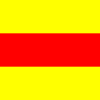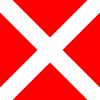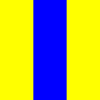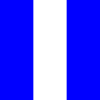
Naval flag signalling
Encyclopedia
Naval flag signalling covers various forms of flag signalling, such as semaphore
or flaghoist, used by various navies; distinguished from maritime flag signalling
by merchant or other non-naval vessels or flags used for identification.
(431 – 401 BCE) squadrons of Athenian galleys were described by Thucydides
as engaging in coordinated maneuvers which would have required some kind of communication; there is no record of how such communication was done but flags would have been the most likely method.
Flags have long been used to identify a ship's owner or nationality, or the commander of a squadron. But the use of flags for signalling messages long remained primitive, as indicated by the 1530 instruction that when the Admiral
Several wars with the Dutch in the 17th century prompted the English to issue instructions for the conduct of particular fleets, such as (in 1673) the Duke of York's "Instructions for the better Ordering of His Majesties Fleet in Sayling". Signals were primitive and rather ad hoc ("As soon as the Admiral shall loose his fore-top and fire a gun..."), and generally a one-way communication system, as only flagships carried a complete set of flags. In 1790 Admiral Lord Howe
issued a new signal book for a numerary system using numeral flags to signal a number; the number, not the mast from which the flags flew, indicated the message. Other admirals tried various systems; it was not until 1799 that the Admiralty issued a standardized signal code system for the entire Royal Navy. This was limited to only the signals listed in the Signal-Book. In 1800 Captain Sir Home Popham devised a means of extending this: signals made with a special "Telegraph" flag refererred to a separate dictionary of numbered words and phrases. A similar system was devised by Captain Marryat in 1817 "for the use of vessels employed in the merchant service".
Marryat's Code of Signals and various competitors have been supplanted by the International Code of Signals
(ICS) for general maritime use. Most navies now use the flags of the ICS for 26 letters A through Z, sometimes augmenting them with additional flags for other national characters. But they retain additional flags for naval usage (such as related to maneuvering or status), and use their own codes. E.g., in the ICS the single flag Mike means the vessel is stopped; in the U. S. Navy it means the duty medical officer is on-board.
Flaghoist was the only way ships could signal prior to the advent of radio and blinking light
. Even now it is often the preferred method of signalling messages of local significance. A radio message that "[ship's call sign] is fueling, everyone stand clear" is incomplete without information as to where the ship is; it is also distracting for many remote parties that are not affected, and congests the radio channel. Flying the Bravo flag is complete information: "danger, stand clear of here". It also communicates to all local parties, including personnel in the vicinity, or in passing small boats that do not have radios. Similarly, a radio message to the effect "this is the admiral, follow me" could lead to disaster if anyone mistook which ship the admiral is on.
Semaphore
A semaphore telegraph, optical telegraph, shutter telegraph chain, Chappe telegraph, or Napoleonic semaphore is a system of conveying information by means of visual signals, using towers with pivoting shutters, also known as blades or paddles. Information is encoded by the position of the...
or flaghoist, used by various navies; distinguished from maritime flag signalling
Maritime flag signalling
Maritime flag signalling, generally flaghoist signalling, is the principal means other than radio by which ships communicate to each other or to shore; distinguished from flags showing nationality, ownership, or organizational status...
by merchant or other non-naval vessels or flags used for identification.
History
Naval flag signalling undoubtably developed in antiquity in order to coordinate naval action of multiple vessels. In the Peloponnesian WarPeloponnesian War
The Peloponnesian War, 431 to 404 BC, was an ancient Greek war fought by Athens and its empire against the Peloponnesian League led by Sparta. Historians have traditionally divided the war into three phases...
(431 – 401 BCE) squadrons of Athenian galleys were described by Thucydides
Thucydides
Thucydides was a Greek historian and author from Alimos. His History of the Peloponnesian War recounts the 5th century BC war between Sparta and Athens to the year 411 BC...
as engaging in coordinated maneuvers which would have required some kind of communication; there is no record of how such communication was done but flags would have been the most likely method.
Flags have long been used to identify a ship's owner or nationality, or the commander of a squadron. But the use of flags for signalling messages long remained primitive, as indicated by the 1530 instruction that when the Admiral
doth doth shote of a pece of
Ordnance, and set up his Banner of Council on Starrborde bottocke of his
Shippe, everie shipps capten shall with spede go aborde the Admyrall to
know his will.
Several wars with the Dutch in the 17th century prompted the English to issue instructions for the conduct of particular fleets, such as (in 1673) the Duke of York's "Instructions for the better Ordering of His Majesties Fleet in Sayling". Signals were primitive and rather ad hoc ("As soon as the Admiral shall loose his fore-top and fire a gun..."), and generally a one-way communication system, as only flagships carried a complete set of flags. In 1790 Admiral Lord Howe
Richard Howe, 1st Earl Howe
Admiral of the Fleet Richard Howe, 1st Earl Howe KG was a British naval officer, notable in particular for his service during the American War of Independence and French Revolutionary Wars. He was the brother of William Howe and George Howe.Howe joined the navy at the age of thirteen and served...
issued a new signal book for a numerary system using numeral flags to signal a number; the number, not the mast from which the flags flew, indicated the message. Other admirals tried various systems; it was not until 1799 that the Admiralty issued a standardized signal code system for the entire Royal Navy. This was limited to only the signals listed in the Signal-Book. In 1800 Captain Sir Home Popham devised a means of extending this: signals made with a special "Telegraph" flag refererred to a separate dictionary of numbered words and phrases. A similar system was devised by Captain Marryat in 1817 "for the use of vessels employed in the merchant service".
Marryat's Code of Signals and various competitors have been supplanted by the International Code of Signals
International Code of Signals
The International Code of Signals is an international system of signals and codes for use by vessels to communicate important messages regarding safety of navigation and related matters. Signals can be sent by flaghoist, signal lamp , flag semaphore, radiotelegraphy, and radiotelephony...
(ICS) for general maritime use. Most navies now use the flags of the ICS for 26 letters A through Z, sometimes augmenting them with additional flags for other national characters. But they retain additional flags for naval usage (such as related to maneuvering or status), and use their own codes. E.g., in the ICS the single flag Mike means the vessel is stopped; in the U. S. Navy it means the duty medical officer is on-board.
Flaghoist was the only way ships could signal prior to the advent of radio and blinking light
Signal lamp
A signal lamp is a visual signaling device for optical communication . Modern signal lamps are a focused lamp which can produce a pulse of light...
. Even now it is often the preferred method of signalling messages of local significance. A radio message that "[ship's call sign] is fueling, everyone stand clear" is incomplete without information as to where the ship is; it is also distracting for many remote parties that are not affected, and congests the radio channel. Flying the Bravo flag is complete information: "danger, stand clear of here". It also communicates to all local parties, including personnel in the vicinity, or in passing small boats that do not have radios. Similarly, a radio message to the effect "this is the admiral, follow me" could lead to disaster if anyone mistook which ship the admiral is on.
Numerals
| Numeral: | 0 | 1 | 2 | 3 | 4 | 5 | 6 | 7 | 8 | 9 |
| NATO |  |
 |
 |
 |
 |
 |
 |
 |
 |
 |
| ICS |  |
 |
 |
 |
 |
 |
 |
 |
 |
 |
Substitutes
These flags indicate a repeat of the first, second, etc., flag in that hoist.  |
 |
 |
 |
|
| First substitute | Second substitute | Third substitute | Fourth substitute | |
Naval manuevering signals |
||||
 |
 |
 |
 |
 |
| Code/answer (ANS) | Preparative (PREP) | Question (INT) | Negation (NEGAT) | Designation (DESIG) |
 |
 |
 |
 |
 |
| Course Pennant (CORPEN) | Turn (TURN) | Screen (SCREEN) | Speed (SPEED) | Station (STATION) |
 |
 |
 |
 |
 |
| Port (PORT) | Starboard (STBD) | Formation (FORM) | Division (DIV) | Squadron (SQUAD) |
 |
 |
 |
||
| Group (FLOT) | Subdivision (SUBDIV) | Emergency (EMERG) | ||
See also
- Bunting tosserBunting tosser'Bunting tosser' or 'Bunts' is an informal term used in the Royal Navy to describe the sailors who hoist signal flags. Although dating from the period of signalling by flags , it has survived as a general term for naval signallers...
- England expects that every man will do his dutyEngland expects that every man will do his duty"England expects that every man will do his duty" was a signal sent by Admiral Horatio Nelson, 1st Viscount Nelson from his flagship HMS Victory as the Battle of Trafalgar was about to commence on 21 October 1805. Trafalgar was the decisive naval engagement of the Napoleonic Wars...
(a famous flag signal). - Maritime flag signallingMaritime flag signallingMaritime flag signalling, generally flaghoist signalling, is the principal means other than radio by which ships communicate to each other or to shore; distinguished from flags showing nationality, ownership, or organizational status...
- SemaphoreSemaphoreA semaphore telegraph, optical telegraph, shutter telegraph chain, Chappe telegraph, or Napoleonic semaphore is a system of conveying information by means of visual signals, using towers with pivoting shutters, also known as blades or paddles. Information is encoded by the position of the...
- Signal lampSignal lampA signal lamp is a visual signaling device for optical communication . Modern signal lamps are a focused lamp which can produce a pulse of light...
- International Code of SignalsInternational Code of SignalsThe International Code of Signals is an international system of signals and codes for use by vessels to communicate important messages regarding safety of navigation and related matters. Signals can be sent by flaghoist, signal lamp , flag semaphore, radiotelegraphy, and radiotelephony...
- Russian Navy Code of SignalsRussian Navy Code of SignalsThe Russian Navy Code of Signals is a collection of flaghoist signals, which is used together with semaphore alphabet for the transmission of information between the ships of the Russian Navy and also with the shore. Its use resembles that of the signals of other navies but it is only used within...
External links
- Royal Navy Signal Flags and Pendants
- Sea Flags (Joseph McMillan)
- Historic Modes of Naval Communication (Captain Howeth)
- Flag Signalling at Sea (Captain Barrie Kent) Nice article.
- NATO flags (Flags of the World)
- Signal flags of the Imperial Japanese Navy (World War II).
- Russian signalling flags.
- Signalman 3 & 2 manual used to train U.S. Navy signalmen; detailed coverage of procedure.

